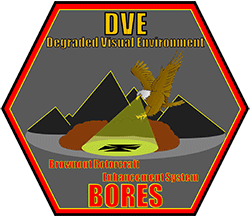
Aviation Support /By LTC David Weese: Degraded visual environment technology will provide Army Aviation the ability to maintain tactical advantage over adversaries by enabling rotary wing platforms to operate in all environmental conditions, even those compromised by natural or manmade obscurants.
The Army is following a proven military acquisition model by capitalizing on new and maturing technologies. This approach mirrors the Night Vision Goggles (NVGs) model, which produced equipment that has provided the military with a significant advantage for decades.
 The required capability is identifying and displaying flight hazards, natural or manmade, so that crews can facilitate safe handling and maintaining precise location through all modes of flight in all DVEs. Obscurants such as dust, smoke, fog, rain, and snow, limit the operational envelope. With DVE technology, rotary wing aviation will no longer be inhibited by environmental factors. Just as NVG technology enabled U.S. Soldiers to “Own the Night,” DVE technology will enable U.S. Aviators to “Own the Environment.”
The required capability is identifying and displaying flight hazards, natural or manmade, so that crews can facilitate safe handling and maintaining precise location through all modes of flight in all DVEs. Obscurants such as dust, smoke, fog, rain, and snow, limit the operational envelope. With DVE technology, rotary wing aviation will no longer be inhibited by environmental factors. Just as NVG technology enabled U.S. Soldiers to “Own the Night,” DVE technology will enable U.S. Aviators to “Own the Environment.”
DVE Impacts on Army Aviation
Rotary wing operations in DVE conditions pose significant risk to pilots and crew, due to the likelihood of accidents caused by partial or total visibility loss. Existing and changing weather are not the only challenges. Calm conditions can quickly degrade during landing or maneuvering. DVE poses more than an operational risk; it is an everyday safety issue that must be mitigated in order to save lives. DVEs are a primary contributing factor in Army Aviation accidents, accounting for approximately a quarter of the Class A/B flight accidents and over 80% of the fatalities from 2002-2015. The materiel cost alone is estimated in excess of $1 billion. The human cost is incalculable.
The Army has defined 11 types of naturally occurring and manufactured DVEs: brownout, sand, smoke, smog, clouds, fog, rain, snow, whiteout, night, and flat light. Initial development will focus on enabling safer flight in brownout, the dust and dirt clouds responsible for nearly 60% of all DVE-related accidents and losses to date.
The Development Path
In 2007, the Army began exploring concepts to mitigate DVE-related accidents and losses; today’s DVE efforts all stem from a functional area analysis (FAA) completed by the U.S. Army Aviation Center of Excellence (USAACE) in September 2007. The Army formed a BORES Analysis of Alternatives (AoA) team in late 2014, which concluded that a single sensor system could not meet the operational DVE capability requirement. Shortly after the April 2015 AoA approval, the Army Acquisition Executive (AAE) directed the Program Executive Office Aviation (PEO AVN) to explore a multi-sensor solution. In response to the AAE guidance, PEO AVN established the DVE/BORES Product Office under the Aviation Systems (AS) Project Office in August 2015.
 The DVE/BORES Product Office is charged with identifying and providing a forward-looking capability that will mitigate risk in brownout for rotary wing aircraft conducting intentional ground approach, limited hover and ground taxi, and take off. The BORES capability will field to a limited number of aircraft as a first step in developing a full DVE solution.
The DVE/BORES Product Office is charged with identifying and providing a forward-looking capability that will mitigate risk in brownout for rotary wing aircraft conducting intentional ground approach, limited hover and ground taxi, and take off. The BORES capability will field to a limited number of aircraft as a first step in developing a full DVE solution.
The team immediately began working with industry, the science and technology (S&T) community, academia, and sister service agencies to assess current Government and industry development efforts and technology readiness levels (TRLs), and the ability to integrate existing and planned technology onto Army rotary wing platforms. Data was further expanded by an industry-wide request for information (RFI) issued by the Army Contracting Command (ACC) in November 2015.
The Product Office is currently exploring technology incorporating a fused image of long wavelength infrared (LWIR) with a Christiansen Feature, millimeter wave (MMW) radar, and laser imaging detection and ranging (LiDAR). Options include fusing sensor data with geospatial data in a synthetic vision solution overlaid with symbology to provide a capability to mitigate brownout conditions.
- Looking Ahead
- Under the current schedule, the Army will field this capability beginning in Fiscal Year 2021 (FY21) and complete an Initial Operational Capability (IOC) by early FY24. The first aircraft planned to receive a brownout solution is the CH-47F, followed by the UH-60M and the HH-60M.
- Heading in to FY17, the DVE/BORES Product Office will continue to:
- Design and develop the system and sub-systems for Milestone B (MS B)
- Conduct hardware and software Developmental Testing (DT)
- Develop and test Design Assurance Level (DAL) software
- Continue aircraft integration
- Perform system modeling and simulation activities
- Complete the Preliminary and Critical Design Reviews (PDR/CDR)
- Continue the development of integration MaintenanceWork Order (MWO) procedures for hardware integration and initiate software modifications to the H-60M Blackhawk
- Aviation Trainer (BAT) and the CH-47F Transportable Flight Proficiency Simulator (TFPS)
The DVE/BORES solution is the first planned iteration of a full DVE capability. Owning the environment depends upon a capability enabling aviators to intentionally operate and perform every maneuver, to include combat maneuvers, in a DVE as if they were in Visual Meteorological Conditions (VMC).
Coordination continues with agencies synchronizing S&T efforts of experimentation and demonstration to develop a fully integrated DVE system compatible with existing and future helicopter systems that enable full-spectrum rotary wing operations in all terrain, weather, and battlefield environments.
LTC David Weese is the product lead for DVE/BORES in the Aviation Systems Project Office, Program Executive Office, Aviation located at Redstone Arsenal, AL.
Rotorcraft operations in brownout. / PM DVE-BORES GRAPHIC
























